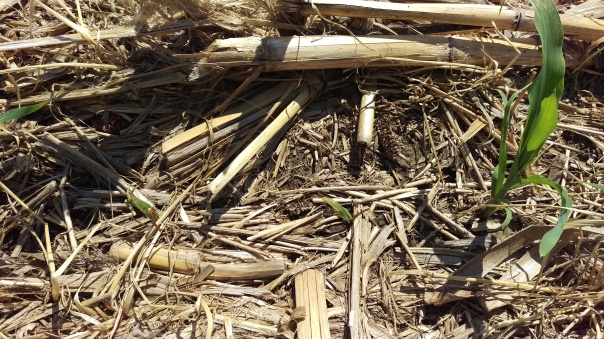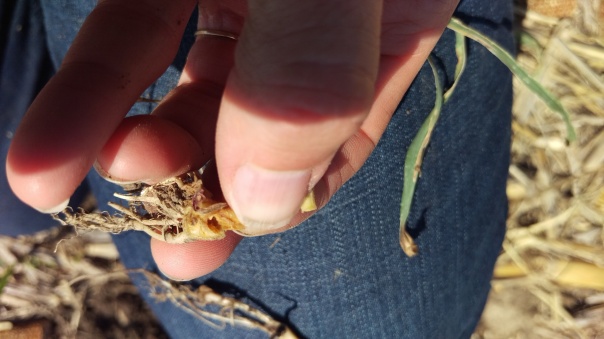Blog Archives
JenREES 4-29-18
Crop Update: It’s nice to see some signs of spring with planters going this  week/weekend, crabapples and flowering pear trees in bloom, and tulips budded! The York County Corn Grower plot got planted on Saturday and grateful for Ron and Brad Makovicka’s efforts with that and for all our participating companies!
week/weekend, crabapples and flowering pear trees in bloom, and tulips budded! The York County Corn Grower plot got planted on Saturday and grateful for Ron and Brad Makovicka’s efforts with that and for all our participating companies!
Rain did help the top foot of sensors in some locations I’ve been monitoring for pre-plant soil moisture. The graphs will be up at http://jenreesources.com by noon on Monday. The cooperators have all been interested in continuing to monitor moisture in these fields post-planting, so will plan to do that and add a York and Seward location too. I’m noticing in York as lawns are greening up, that portions are looking gray-green in color where trees are located in them.
As of April 26th, I hadn’t found any wheat jointing yet. The growing point was just approaching ground level in several fields I checked. We also need to keep an eye out for stripe rust as incidence is increasing in Kansas fields. There’s articles focusing on winter wheat in this week’s UNL CropWatch at http://cropwatch.unl.edu including nitrogen management and Nebraska wheat progress.
Wheat Stem Maggots (WSM) in Rye/Wheat Cover Crops: I meant to provide an update in last week’s column. Dr. Justin McMechan has been scouting wheat and rye cover crop fields for wheat stem maggots. So far, he captured one adult wheat stem maggot on April 16 in 100 sweeps from a wheat cover crop planted in late September at the Eastern Nebraska Research and Extension Center near Ithaca. He shared that “adults have been consistently collected at this location since first emergence with one to two found per 100 sweeps. This first occurrence of adults matches closely with data collected in 1933 by Merle Allen from Kansas State University. Our latitude north of Kansas and cold spring suggests this emergence might be earlier than Allen’s data. On April 23 two adults were collected at Clay Center and a single adult was collected near Marquette. Cover crops in these fields were less than 6 inches in height, with the field near Marquette grazed to approximately 3 inches in height. Sweeping these fields is challenging due to the height of the vegetation so adult captures are not likely to represent true numbers in the field. If you are skilled with a sweep net, we encourage you to sweep your wheat, rye, or triticale cover crops for wheat stem maggot adults.” At this point we’re not recommending any insecticide treatments. An interesting observation that a couple of Clay and Adams county farmers mentioned to me last year was they noticed the presence of a lot of flies as they planted corn into green rye and terminated at or after planting corn. The adult WSM is a small fly and you can see photos in Justin’s report in this week’s UNL CropWatch at http://cropwatch.unl.edu.
Which dicamba product before Xtend soybean: This has been a fairly common question this spring which Dr. Amit Jhala addressed in this week’s UNL CropWatch. I’ve also provided his answer here. “I recently received several phone calls from growers with questions on terminating broadleaf cover crop species and broadleaf weeds using dicamba products. They were particularly interested in whether dicamba products such as Banvel, Clarity, DiFlexx, etc. can be applied to terminate broadleaf cover crop species such as hairy vetch, field peas, or mixtures and broadleaf weeds such as henbit, field pennycress, or marestail immediately before planting Xtend soybean. The answer for the dicamba-based herbicides listed above is NO. Their labels have soybean planting intervals of 14 to 60 days, depending on the product and its use rates.
For example, for Clarity to be applied at 16.0 fl oz/acre, there would be a 28-day soybean planting interval after an inch of rain. If Clarity were to be applied at 8.0 fl oz/acre, the soybean planting interval would be 14 days after an inch of rain. The Clarity label also specifies: “Do NOT make Clarity burndown applications to soybeans in geographic areas with average annual rainfall less than 25 inches.”
If DiFlexx is applied burndown at 24 fl oz/acre or less, the planting interval for soybean is 60 days. This longer planting interval must be applied because Xtend soybean is not listed on Banvel, Clarity, DiFlexx, or other dicamba products.
Dicamba-resistant soybean, also known as Xtend soybean, became available commercially for the 2017 growing season. Three dicamba products (FeXapan, Engenia, XtendiMax) are labeled to be applied pre-plant, pre-emergence, or post-emergence (up to R1 soybean growth stage) for broadleaf weed control in Xtend soybean. You can use FeXapan, Engenia, or XtendiMax as per label requirements in burndown application and plant Xtend soybean without a planting interval.
If you apply 2,4-D prior to planting soybean, be sure to adhere to the planting interval specified on the label. Several 2,4-D products have different planting intervals for soybean, ranging from 7 to 30 days depending on product and application rate. (See this Crop Watch article.)”
Corn Concern in Wheat/Rye Cover

What we see is larger plants next to stunted or shorter plants. The smaller plants often show some type of ‘flagging’ of the leaves where one or several leaves or sometimes the whorl is brown and wilted. Upon digging these plants, the roots were healthy and there were no symptoms of damping off or other obvious disease issues. While there have been reports of some wireworms, this also hasn’t been the main issue with these plants I’ve been seeing.

John Mick with Pioneer alerted me to what he was seeing and several of us have since found the same. Carefully unrolling leaves from the stems of these plants revealed feeding on the stems and crown area. You can see from this photo the small larva of what we believe to be wheat stem maggots (top leaf). I’m finding from 1-3 per plant (on this plant there were more in the disfigured area of the stem). I’m also noticing some plants that are tillering such as is shown in this photo after they’ve been damaged.

The larva in another plant.

The growing point area of the same plant.

Carefully unroll the leaves to reveal any potential larvae.

Also found wheat stem maggot in some rye stems from rye that didn’t completely die. White heads in wheat and rye can be an indication of their feeding. You can then pull on the head and easy removal reveals where the maggot was feeding.
So two questions:
- Why are we seeing this this year?
- Is there anything we need to do?
The short answer to both is that we really don’t know. Perhaps one hypothesis is our warm winter allowed for an earlier generation of wheat stem maggots to pupate and emerge as flies during corn planting when they would typically do so later in May. Perhaps in fields where wheat or rye wasn’t yet terminated, the flies could lay eggs and the larvae that hatched moved from the wheat or rye to the corn upon emergence and once the cover was terminated.
The larvae we’re finding now are in different stages and some are getting close to pupating. After pupating, they will emerge into flies that will lay eggs in grass crops. We don’t know for certain if the flies will lay eggs in these corn fields again or if they will move to other grassy species. We’re not recommending insecticide applications.
South Dakota State and Kansas State have previously reported rare incidences of this occurring in corn. This is my first time observing this in Nebraska. To date, I’ve seen stand loss range in fields from 5-50%.
This doesn’t mean that all potential stunted plants or stand concerns are due to this particular insect as a number of other factors could be involved. This post is intended to increase awareness of another option to look for with the number of questions I’m receiving right now regarding corn concerns in terminated rye or wheat cover.
Dr.s Justin McMechan and Bob Wright are surveying fields and conducting studies to better understand any potential concerns in future years. We will keep you informed as we continue to learn more.

